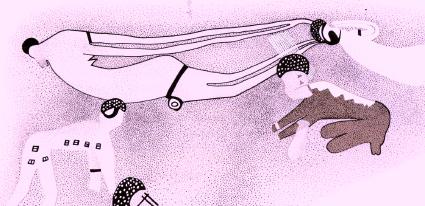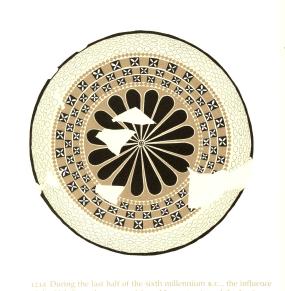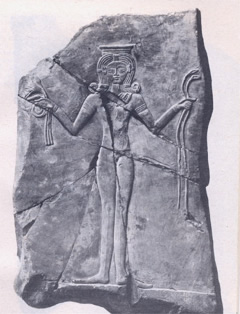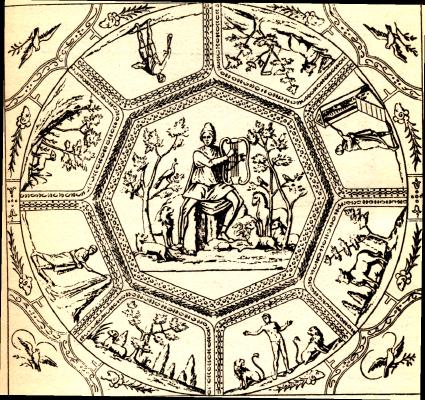| 
|
|
The Gnostic Gallery
A Brief Visual Tour
of Evidence for Gnostics and the Mysteries
One of the difficulties we face in getting a clear sense of
Gnostics, Pagan religion, and the Mysteries, is the lack of tangible
evidence. Most of the original literature of Pagan spirituality
was intentionally destroyed, and the rest was eaten by the ravages
of time. The Greek dramatist Aeschylus wrote over ninety plays,
of which nine have survived intact. This is a good benchmark.
About ten percent or less of all Pagan literature survives, and
probably less than one-tenth of one percent of Gnostic writings
and textual material collected in the libraries attached to the
Mystery Schools. (On the Coptic Gnostic texts found in Egypt
in 1945, see When the Mysteries Died.)
What of other evidence, such as artifacts and architecture?
Consider the Greco-Roman ruins spread
across Europe from the western shores of Ireland and Scotland
down to
the tip of the Iberian peninsula, around the Mediterranean basin
and throughout Egypt and the Levant—all this is evidence
of Pagan religion and the widespread network of the Mysteries.
In
many
cases, the
ruins of classical world are superposed over another layer of
evidence: the megalithic constructions of prehistory. The sacred
grottos of the Black Virgin, for instance, became the sites for
cathedrals and abbeys at Chartres, Glastonbury, and elsewhere.
Shamanic religion in Europa was the prehistorical matrix of the
Mysteries. This archeological evidence is also spread all across
Europe and into the Middle East.
The purpose of this gallery is to display non-textual evidence
presenting
visual
traces
of
the
Mysteries
and the
Gnostic
seers, the telestai, who directed them. In some cases,
the evidence points in a general way to Pagan religion, in
other instances, it indicates specific aspects of Gnostic practice
and Mystery ritual. The value of this evidence lies in its
visual impact (short of going to the places depicted), but
I have supplied brief comments to describe.
ONE: From Prehistory to Delphi 
The religion of nature, reflecting the Pagan
sense of life, began with intense immersion in nature. In the
wake of the last deglaciation, circa 10,000 BCE, technology
was
dedicated
to
ritual
arrangement of
sacred
sites. Pombos Dolmen, Portugal. (Julien Cope, The Megalithic
European, p. 424.)

All over Europe, megalithic sites were carefully
aligned to the cardinal points, sunrise and sunset, moonrise
and moonset, and the wheeling of the stars. Some sites, such
as Callanish on the Isle of Lewis in the Hebrides, display an
astronomical sophistication that is astonishing. (Photograph
by Rod Bull in Time Stands Still.)

The "White Lady" of Tassili n'Ajjer in the
mountains of Algeria commemorates a female shaman dancer,
typical of the late Paleolithic cultures that preceded the
age of the
sacred megaliths. Gnosticism derives from archaic practices
of shamanism in which women played an equal, if not dominant
role. (Rock carving in yellow ochre with white spots in red
lines.)

Intimate contact with the "animal powers"
was typical of archaic shamanism. Curiously, ancient seers
found
these powers in the distant skies as well as in the animal
kingdom, not to mention the psychic world. Subterranean caves
were repositories of animal power, the treasuries of the
Goddess. Megalithic sites were devices for monitoring the
animating
powers of the
cosmos. In its late, classical forms, Gnosticism preserved
a highly sophisticated knowledge of astronomy, and relegated
animal powers to an infra-psychic status.

In England, Scotland, Ireland and Wales, many
sites are located in remote places of extraordinary beauty.
The astronomical alignment
of the megalithic circles such as Moel Ty Uchaf in North Wales
incorporates the geometry of pentagon and heptagon.
The interaction between the site and its setting (earth
and sky)
generates an undeniable esthetic effect and may spontaneously
produce altered states of consciousness. (Photograph
by Rod Bull in Time
Stands Still.)

Male shaman in out-of-the-body trance, or
astral projection. His sleeping form is shown on the right.
Eliade emphasized the "archaic techniques of ecstasy," including
trance journeys, in Siberian shamanism, but the practice was
universal. Gnostics refined the techniques of astral projection,
remote viewing, and lucid dreaming —such techniques being
the source of much of the cosmological knowledge, including
their detection of alien intrusion. Shamans in North Africa
previous to 6000 BCE would have participated in
the
Sarahasian
culture
that
spread
across
North Africa and through the Nead East into Iran, before the
great drought and desertification. (Roundhead rock painting
from Aouanrhet, Algeria. In Settegast, Plato
Prehistorian, fig. 59)

Fantastically constructed underground chambers
such as Hal Saflieni (circa 4000 BCE) on the island of Malta
were used for initiatory
rites of which scholars and archeologists, who consider them
to be burial chambers, have no firsthand experience. The shift
from shamanic exploits in the hunter/gatherer setting of open
nature to subterranean rites indicates (in one aspect) the
interiorization of the human psyche, a trend leading eventually
to urban organization
and human-made cultures totally enclosed upon themselves. (Julian
Cope, The
Megalithic European,
p. 318)

The rise of urban civilization in the Fertile
Crescent depended on the theocratic system of empowerment,
which became male-dominated over time, especially after 1800
BCE. The Zoroastrian priesthood of the Magi, source of the
Gnostic movement, originated around 6000 BCE in northwestern
Iran, in the plateau between Lake Urmia and the Caspian Sea
(main archeological sites, Yanik Tepe and Hajii Firuz). Map
from Mary Settegast, Plato Prehistorian.
There was a split in the Magian Order over
the issue of whether initiates should be involved in statecraft
and theocratic politics. From Lake Urmia, the politically oriented
Magi moved down into Mesopotamia and set up urban theocracies,
but the non-political initiates (later called Gnostics) moved
westward, toward Catal Huyuk in Turkey, and into the Levant
and Egypt where they established the network of Mystery Schools.

Many megalithic circles
were constructed in the open for celebration of public and
popular rites, contrasted to the more secret initiations performed
in
dolmens
and underground chambers. Chromeleque dos Almendres, Portugal.
Julian Cope, The Megalithic European, p. 397).

Map showing dissemination of the Gnostic movement
(gold) from the Urmian plateau into Anatolia and Greece, and
southward into the Levant, Palestine, and Egypt, contrasted
to the Magi who
chose
to
set up and
direct theocracies in the urban cultures of the Fertile Crescent
(blue).

As megalithic sites slowly morphed into temple
precincts, the "underworld" (where non-public initiatory
rites were performed) remained in close and intimate relation
whip with more formal
structures. The Cave of Hades at Eleusis. (In Temples and
Sanctuaries of Ancient Greece, p. 78)

In all indigenous cultures, sacred sites in
nature, and, later, temple sites, were dedicated to the Great
Goddess who represented
the divinity of the Earth. As an image of the fecundity
of nature, she was a "fertility goddess," the residing
spirit of the land, giver of grain, mistress of animals. In
the cultural
perspective, she was the matrix of erotic powers as well as
the superhuman force that drove men into conflict when her
laws were disrupted. Ugarit Goddess with goats and grain.

The Sumerian God Enki represents the model
of the ancient theocrat or male chieftain in the first urban
societies.
He was responsible for irrigation of the land, sailing, medicine
(with his half-sister Ninhursag), and other "arts of civilization."
Such theocrats were originally empowered by the goddess cults,
but eventually broke away to form a male-only system of social
and spiritual
authority. Cylinder seal of Enki and attendants.

From 6000 BCE artifacts from
the Halafian culture in northwestern Iran, the geographical
matrix of Gnosticism, were distributed as far as Anatolia,
Syria,
and Greece. Deep in prehistorical times, the organization of
the Mystery cells was determined on an 8-16 pattern, clearly
preserved at Eleusis and elsewhere. This Halafian dish may
have been purely utilitarian, a household commodity, yet it
preserves
the archetypal pattern associated with entheogenic ritual—proving,
perhaps, that the mundane ceremony of eating was based on sacred
norms. (Mary Settegast, Plato Prehistorian, Plate
121a)

A thick flat Celtic stone dish (the "Belenus
Bowl") resembles
the MesoAmerican metote for grinding corn and
mixing sacred herbs. A prototype
of the Grail, it displays letters around the rim. Ceremonial
bowls are among the earliest evidence we have of entheogenic
rites in Pagan Europa. but the ritual significance of these
artifacts is not evident until a later period when participation
in the
Mysteries required special utensils.
 The
Goddess Hathor, the Egyptian Eve, was often pictured with an "omega"-style
hairdo, representing the internal structure of the female organs
of reproduction (fallopian tubes). Here she is pictured with two
snakes in her left hand and sacred herbs in her right. Hathor is
one of many goddesses associated with childbirth, healing, the
preparation of sacred planets, and the serpent power (Kundalini).
In prehistoric times before temples were build, naked priestesses
of her cult would have prepared entheogenic potions for initiation. The
Goddess Hathor, the Egyptian Eve, was often pictured with an "omega"-style
hairdo, representing the internal structure of the female organs
of reproduction (fallopian tubes). Here she is pictured with two
snakes in her left hand and sacred herbs in her right. Hathor is
one of many goddesses associated with childbirth, healing, the
preparation of sacred planets, and the serpent power (Kundalini).
In prehistoric times before temples were build, naked priestesses
of her cult would have prepared entheogenic potions for initiation.

In
the division of labor in prehistory, men undertook animal
husbandry and pasturing. (The practice of breeding animals to
produce finer or stronger types led to the notion
of human eugenics, rigorously applied in selective
breeding of the pharoanic family-lines.) When blood-line manipulation
merged with theocracy, it affected a
deep split between the genders, with all-male domination becoming
the norm in urban societies. But in Pagan religion throughout
the Near East, the good shepherd Dumuzi was always viewed as
subordinate to his consort, the Goddess.
Hermes kriophorus
(c. 1800 BC) is an archaic Greek demigod who became identified
with the good shepherd in Pagan culture. Later, this figure
was coopted
by
Christianity
and attached to the savior. Eventually, it morphs into the figure
of Saint Christopher with a child ("the Christ child") on his
shoulders.

Anatolian house shrine, reflecting gender
balance. Catal Huyuk and other Goddess-oriented cultures
in the Near
East, may fit the "gylanic" model of Riane Eisler. If so, the
balance of genders in these ancient, pre-urban societies may
have been a reflection of the egalitarian structure of the
Mysteries.

Mary Settegast says that late Paleolithic
migrations in the Near East brought the Magi movement deep
into Anatolia
where it merged with native ecstatic rites to produce Orphism:
The religion of the Magi and that later to be known as
Orphism became so similar that modern scholars would consider
using
the one system to interpret the other" (Plato Prehistorian,
p. 251) The Orphic Mysteries were hugely observed down into
modern times. Orpheus playing his lyre to tame the animals
is an archaic representation of the Mesotes. (Domatilla Catacomb,
Rome, 3C CE)

The Temple of Apollo at Delphi with the steep
rock face of the Phaedriades behind it. Delphi's prime was
between the 8th and 5th centuries BCE. It represents a classical
Mystery cult center where indigenous shamanism was brought
to a fine art.
Gnostic Gallery 2: The Splendor of the Mysteries
May 2006. Galleries TWO and THREE in development.
jll
|
|
|


